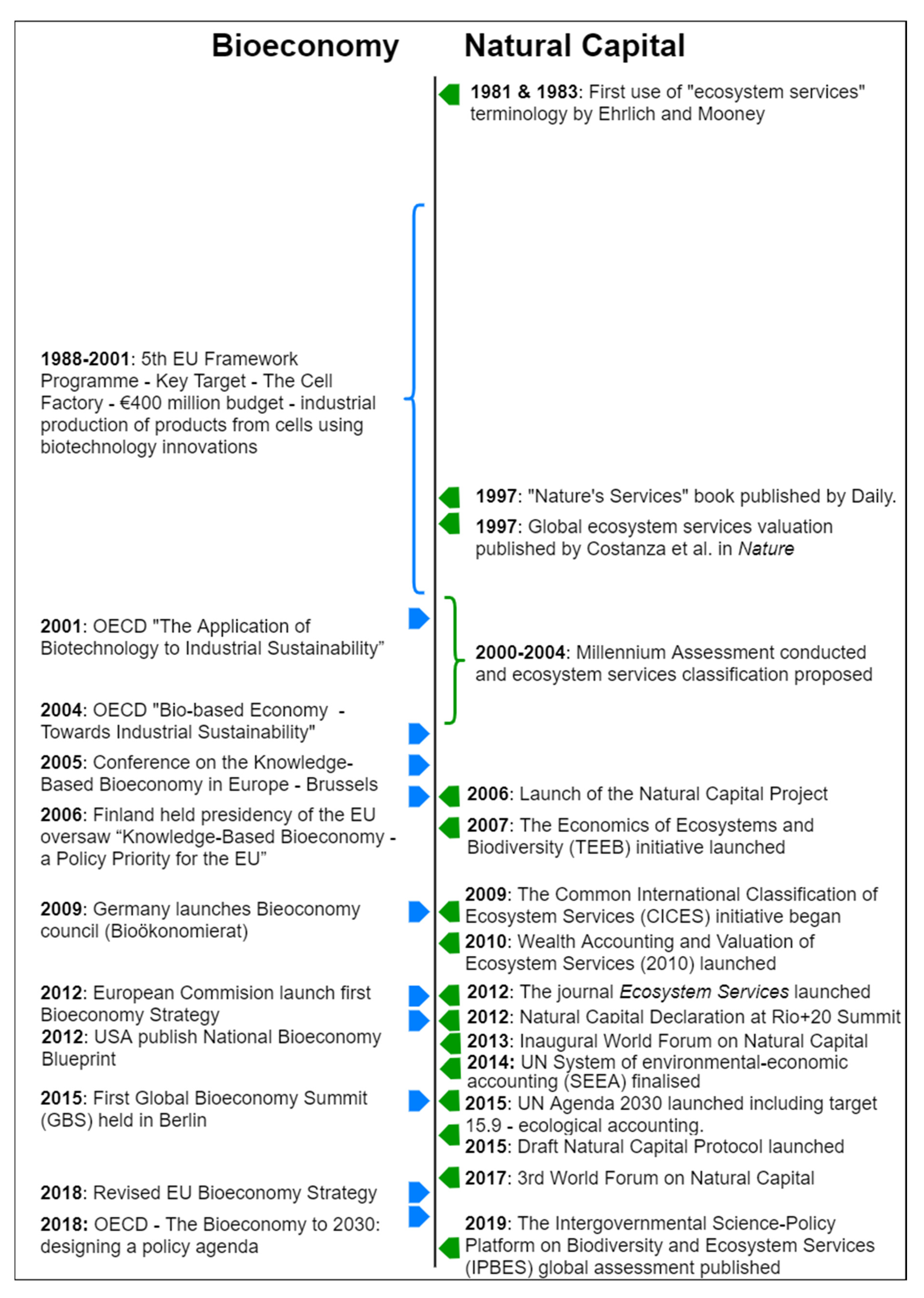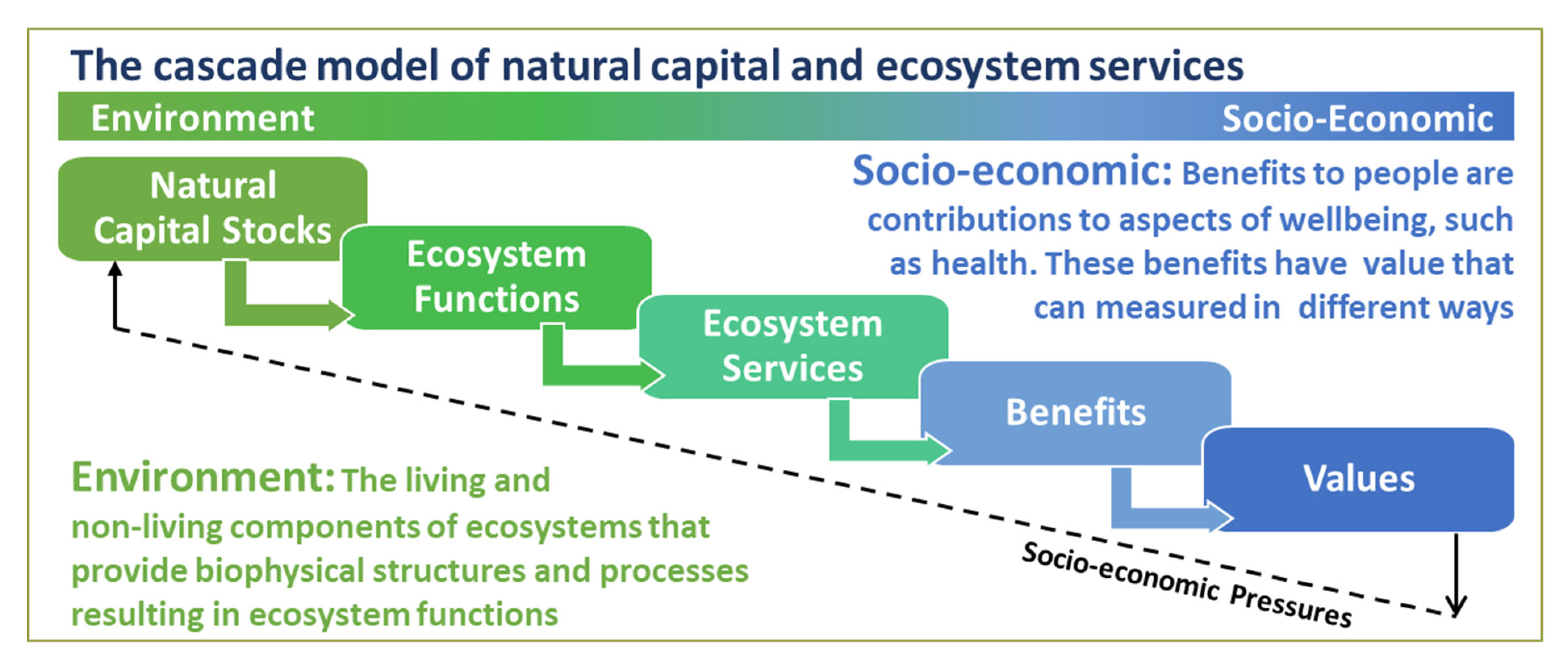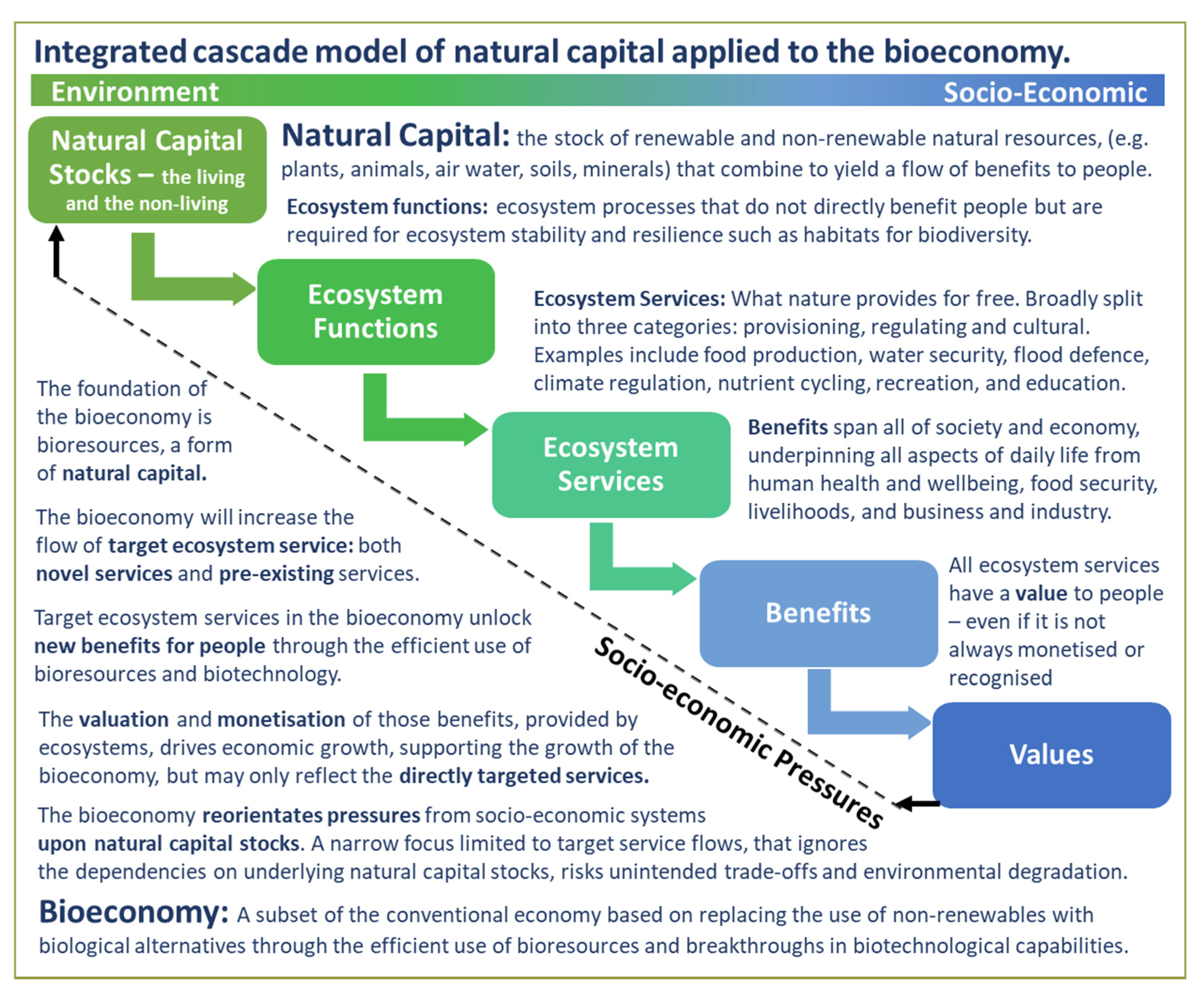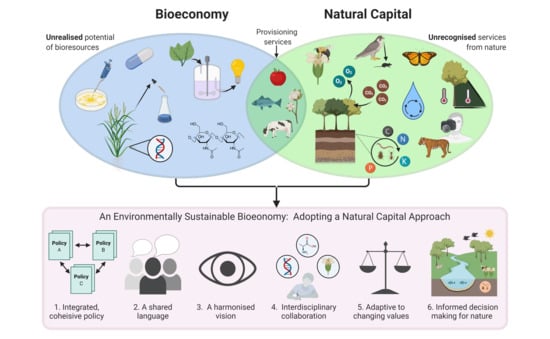A Natural Capital Lens for a Sustainable Bioeconomy: Determining the Unrealised and Unrecognised Services from Nature
Abstract
1. Introduction
1.1. Environmental Sustainability Challenges and Concepts
1.2. The Knowledge Gap
1.3. Objective and Structure
2. Conceptual Framework and Environmental Framings
2.1. The Bioeconomy Concept
2.2. The Natural Capital Concept
2.3. Environmental Framings of the Bioeconomy and Natural Capital
2.4. Uniting the Bioeconomy and Natural Capital – An Integrated Cascade Model
3. Natural Capital and the Cornerstones of a Sustainable, Future Bioeconomy
3.1. Cornerstone 1: International Collaborations between Governments and Public and Private Researchers
3.2. Cornerstone 2: Measurement of the Bioeconomy’s Development and Sustainability Contributions
3.3. Cornerstone 3: Linkages with Multilateral Policy
3.4. Cornerstone 4: Education, Skills, and Knowledge
3.5. Cornerstone 5: Support for Research and Development Programmes
4. A Policy Case Study: Applying a Natural Capital Lens to the EU Bioeconomy Strategy
4.1. The EU Bioeconomy Strategy 2012
4.2. The EU Bioeconomy Strategy Update 2018
4.3. Future Policy and Recommendations
4.3.1. A Shared Language
4.3.2. A Harmonised Bioeconomy
4.3.3. Improved Indicators, Metrics, and Measures
4.3.4. Policy Synergy and Coherence
4.3.5. A Flexible and Adaptable Tool for Decision-Making
5. Conclusions
Author Contributions
Funding
Acknowledgments
Conflicts of Interest
References
- Rockström, J.; Steffen, W.; Noone, K.; Persson, Å.; Chapin, F.S.; Lambin, E.F.; Lenton, T.M.; Scheffer, M.; Folke, C.; Schellnhuber, H.J. A safe operating space for humanity. Nature 2009, 461, 472–475. [Google Scholar] [CrossRef]
- Raudsepp-Hearne, C.; Peterson, G.D.; Tengö, M.; Bennett, E.M.; Holland, T.; Benessaiah, K.; MacDonald, G.K.; Pfeifer, L. Untangling the environmentalist’s paradox: Why is human well-being increasing as ecosystem services degrade? Bioscience 2010, 60, 576–589. [Google Scholar] [CrossRef]
- IPBES 2019. Summary for Policymakers of the Global Assessment Report on Biodiversity and Ecosystem Services of the Intergovernmental Science-Policy Platform on Biodiversity and Ecosystem Services. IPBES Secreteriat: Bonn, Germany. Available online: https://ipbes.net/sites/default/files/inline/files/ipbes_global_assessment_report_summary_for_policymakers.pdf (accessed on 23 August 2020).
- Khanna, M.; Swinton, S.M.; Messer, K.D. Sustaining our Natural Resources in the Face of Increasing Societal Demands on Agriculture: Directions for Future Research. Appl. Econ. Perspect. Policy 2018, 40, 38–59. [Google Scholar] [CrossRef]
- O’Neill, D.W.; Fanning, A.L.; Lamb, W.F.; Steinberger, J.K. A good life for all within planetary boundaries. Nat. Sustain. 2018, 1, 88. [Google Scholar] [CrossRef]
- Zilberman, D.; Gordon, B.; Hochman, G.; Wesseler, J. Economics of sustainable development and the bioeconomy. Appl. Econ. Perspect. Policy 2018, 40, 22–37. [Google Scholar] [CrossRef]
- McCormick, K.; Kautto, N. The bioeconomy in Europe: An overview. Sustainability 2013, 5, 2589. [Google Scholar] [CrossRef]
- Bugge, M.; Hansen, T.; Klitkou, A. What is the bioeconomy? A review of the literature. Sustainability 2016, 8, 691. [Google Scholar] [CrossRef]
- Gawel, E.; Pannicke, N.; Hagemann, N. A Path Transition Towards a Bioeconomy—The Crucial Role of Sustainability. Sustainability 2019, 11, 3005. [Google Scholar] [CrossRef]
- Hausknost, D.; Schriefl, E.; Lauk, C.; Kalt, G. A transition to which bioeconomy? An exploration of diverging techno-political choices. Sustainability 2017, 9, 669. [Google Scholar] [CrossRef]
- Kleinschmit, D.; Arts, B.; Giurca, A.; Mustalahti, I.; Sergent, A.; Pülzl, H. Environmental concerns in political bioeconomy discourses. Int. For. Rev. 2018, 19, 41–55. [Google Scholar] [CrossRef]
- De Schutter, L.; Giljum, S.; Häyhä, T.; Bruckner, M.; Naqvi, A.; Omann, I.; Stagl, S. Bioeconomy Transitions through the Lens of Coupled Social-Ecological Systems: A Framework for Place-Based Responsibility in the Global Resource System. Sustainability 2019, 11, 5705. [Google Scholar] [CrossRef]
- Loiseau, E.; Saikku, L.; Antikainen, R.; Droste, N.; Hansjürgens, B.; Pitkänen, K.; Leskinen, P.; Kuikman, P.; Thomsen, M. Green economy and related concepts: An overview. J. Clean. Prod. 2016, 139, 361–371. [Google Scholar] [CrossRef]
- Pfau, S.; Hagens, J.; Dankbaar, B.; Smits, A. Visions of sustainability in bioeconomy research. Sustainability 2014, 6, 1222–1249. [Google Scholar] [CrossRef]
- Székács, A. Environmental and Ecological Aspects in the Overall Assessment of Bioeconomy. J. Agric. Environ. Ethics 2017, 30, 153–170. [Google Scholar] [CrossRef]
- Sheppard, A.W.; Gillespie, I.; Hirsch, M.; Begley, C. Biosecurity and sustainability within the growing global bioeconomy. Curr. Opin. Environ. Sustain. 2011, 3, 4–10. [Google Scholar] [CrossRef]
- Graham-Rowe, D. Beyond food versus fuel. Nature 2011, 474, S6–S8. [Google Scholar] [CrossRef]
- Eyvindson, K.; Repo, A.; Mönkkönen, M. Mitigating forest biodiversity and ecosystem service losses in the era of bio-based economy. For. Policy Econ. 2018, 92, 119–127. [Google Scholar] [CrossRef]
- Heimann, T. Bioeconomy and SDGs: Does the Bioeconomy Support the Achievement of the SDGs? Earth Future 2019, 7, 43–57. [Google Scholar] [CrossRef]
- Costanza, R.; D’Arge, R.; De Groot, R.; Farber, S.; Grasso, M.; Hannon, B.; Limburg, K.; Naeem, S.; O’Neill, R.V.; Paruelo, J. The value of the world’s ecosystem services and natural capital. Nature 1997, 387, 253–260. [Google Scholar] [CrossRef]
- Barbier, E.B. The concept of natural capital. Oxf. Rev. Econ. Policy 2019, 35, 14–36. [Google Scholar] [CrossRef]
- Costanza, R.; de Groot, R.; Braat, L.; Kubiszewski, I.; Fioramonti, L.; Sutton, P.; Farber, S.; Grasso, M. Twenty years of ecosystem services: How far have we come and how far do we still need to go? Ecosyst. Serv. 2017, 28, 1–16. [Google Scholar] [CrossRef]
- Braat, L.C.; de Groot, R. The ecosystem services agenda: Bridging the worlds of natural science and economics, conservation and development, and public and private policy. Ecosyst. Serv. 2012, 1, 4–15. [Google Scholar] [CrossRef]
- Millennium Ecosystem Assessment. Ecosystems and Human Well-Being: A Framework for Assessment Summary; Island Press: Washington, DC, USA, 2005; ISBN 1-59726-040-1. [Google Scholar]
- Costanza, R.; de Groot, R.; Sutton, P.; van der Ploeg, S.; Anderson, S.J.; Kubiszewski, I.; Farber, S.; Turner, R.K. Changes in the global value of ecosystem services. Glob. Environ. Chang. 2014, 26, 152–158. [Google Scholar] [CrossRef]
- OECD Biodiversity. Finance and the Economic and Business Case for Action. Available online: https://www.oecd-ilibrary.org/environment/biodiversity-finance-and-the-economic-and-business-case-for-action_a3147942-en (accessed on 21 July 2020).
- Hein, L.; Bagstad, K.J.; Obst, C.; Edens, B.; Schenau, S.; Castillo, G.; Soulard, F.; Brown, C.; Driver, A.; Bordt, M.; et al. Progress in natural capital accounting for ecosystems. Science 2020, 367, 514–515. [Google Scholar] [CrossRef] [PubMed]
- Guerry, A.D.; Polasky, S.; Lubchenco, J.; Chaplin-Kramer, R.; Daily, G.C.; Griffin, R.; Ruckelshaus, M.; Bateman, I.J.; Duraiappah, A.; Elmqvist, T. Natural capital and ecosystem services informing decisions: From promise to practice. Proc. Natl. Acad. Sci. USA 2015, 112, 7348–7355. [Google Scholar] [CrossRef]
- Daily, G.C.; Polasky, S.; Goldstein, J.; Kareiva, P.M.; Mooney, H.A.; Pejchar, L.; Ricketts, T.H.; Salzman, J.; Shallenberger, R. Ecosystem services in decision making: Time to deliver. Front. Ecol. Environ. 2009, 7, 21–28. [Google Scholar] [CrossRef]
- Reyers, B.; Selig, E.R. Global targets that reveal the social–ecological interdependencies of sustainable development. Nat. Ecol. Evol. 2020, 4, 1011–1019. [Google Scholar] [CrossRef]
- Ehrlich, P.R.; Mooney, H.A. Extinction, Substitution, and Ecosystem Services. Bioscience 1983, 33, 248–254. [Google Scholar] [CrossRef]
- Patermann, C.; Aguilar, A. The origins of the bioeconomy in the European Union. New Biotechnol. 2018, 40, 20–24. [Google Scholar] [CrossRef]
- Priefer, C.; Jörissen, J.; Frör, O. Pathways to shape the bioeconomy. Resources 2017, 6, 10. [Google Scholar] [CrossRef]
- El-Chichakli, B.; von Braun, J.; Lang, C.; Barben, D.; Philp, J. Policy: Five cornerstones of a global bioeconomy. Nature 2016, 535, 221–223. [Google Scholar] [CrossRef] [PubMed]
- Vainio, A.; Ovaska, U.; Varho, V. Not so sustainable? Images of bioeconomy by future environmental professionals and citizens. J. Clean. Prod. 2019, 210, 1396–1405. [Google Scholar] [CrossRef]
- Ronzon, T.; Sanjuán, A.I. Friends or foes? A compatibility assessment of bioeconomy-related Sustainable Development Goals for European policy coherence. J. Clean. Prod. 2020, 254, 119832. [Google Scholar] [CrossRef] [PubMed]
- Marchetti, M.; Vizzarri, M.; Lasserre, B.; Sallustio, L.; Tavone, A. Natural capital and bioeconomy: Challenges and opportunities for forestry. Ann. Silvic. Res. 2014, 38, 62–73. [Google Scholar] [CrossRef]
- Helming, K.; Daedlow, K.; Paul, C.; Techen, A.K.; Bartke, S.; Bartkowski, B.; Kaiser, D.; Wollschläger, U.; Vogel, H.J. Managing soil functions for a sustainable bioeconomy—Assessment framework and state of the art. Land Degrad. Dev. 2018, 29, 3112–3126. [Google Scholar] [CrossRef]
- D’Amato, D.; Korhonen, J.; Toppinen, A. Circular, Green, and Bio Economy: How Do Companies in Land-Use Intensive Sectors Align with Sustainability Concepts? Ecol. Econ. 2019, 158, 116–133. [Google Scholar] [CrossRef]
- European Commission (EC). Innovating for Sustainable Growth: A Bioeconomy for Europe; EU Publications: Brussels, Belgium, 2012. [Google Scholar]
- Lewandowski, I. Securing a sustainable biomass supply in a growing bioeconomy. Glob. Food Sec. 2015, 6, 34–42. [Google Scholar] [CrossRef]
- OECD. The Bioeconomy to 2030: Designing a Policy Agenda; OECD Publishing: Paris, France, 2009; Available online: https://www.oecd-ilibrary.org/economics/the-bioeconomy-to-2030_9789264056886-en (accessed on 10 January 2020).
- OECD. Biotechnology for Sustainable Growth and Development; OECD Publishing: Paris, France, 2004; Available online: http://www.oecd.org/science/emerging-tech/33784888.PDF (accessed on 26 August 2020).
- European Commission (EC). Updated Bioeconomy Strategy: A sustainable Bioeconomy for Europe: Strengthening the Connection between Economy, Society and the Environment; European Commission: Brussels, Belgium, 2018; Available online: https://ec.europa.eu/research/bioeconomy/pdf/ec_bioeconomy_strategy_2018.pdf#view=fit&pagemode=none (accessed on 26 August 2020).
- Levidow, L.; Birch, K.; Papaioannou, T. EU agri-innovation policy: Two contending visions of the bio-economy. Crit. Policy Stud. 2012, 6, 40–65. [Google Scholar] [CrossRef]
- Korhonen, J.; Koskivaara, A.; Toppinen, A. Riding a Trojan horse? Future pathways of the fiber-based packaging industry in the bioeconomy. For. Policy Econ. 2018, 110, 101799. [Google Scholar] [CrossRef]
- Kleinschmit, D.; Lindstad, B.H.; Thorsen, B.J.; Toppinen, A.; Roos, A.; Baardsen, S. Shades of green: A social scientific view on bioeconomy in the forest sector. Scand. J. For. Res. 2014, 29, 402–410. [Google Scholar] [CrossRef]
- Hodge, D.; Brukas, V.; Giurca, A. Forests in a bioeconomy: Bridge, boundary or divide? Scand. J. For. Res. 2017, 32, 582–587. [Google Scholar] [CrossRef]
- Bueso, Y.F.; Tangney, M. Synthetic biology in the driving seat of the bioeconomy. Trends Biotechnol. 2017, 35, 373–378. [Google Scholar] [CrossRef] [PubMed]
- Mace, G.M. The ecology of natural capital accounting. Oxf. Rev. Econ. Policy 2019, 35, 54–67. [Google Scholar] [CrossRef]
- Obst, C. Reflections on natural capital accounting at the national level: Advances in the system of environmental-economic accounting. Sustain. Account. Manag. Policy J. 2015, 6, 315–339. [Google Scholar] [CrossRef]
- Bateman, I.J.; Mace, G.M. The natural capital framework for sustainably efficient and equitable decision making. Nat. Sustain. 2020. [Google Scholar] [CrossRef]
- Potschin, M.B.; Haines-Young, R.H. Ecosystem services: Exploring a geographical perspective. Prog. Phys. Geogr. 2011, 35, 575–594. [Google Scholar] [CrossRef]
- Natural Capital Coalition. Natural Capital Protocol. Available online: https://naturalcapitalcoalition.org/natural-capital-protocol/ (accessed on 26 August 2020).
- TEEB. The Economics of Ecosystems and Biodiversity: Mainstreaming the Economics of Nature: A Synthesis of the Approach, Conclusions and Recommendations of TEEB. Available online: http://www.teebweb.org/our-publications/teeb-study-reports/synthesis-report/ (accessed on 8 April 2020).
- SEEA. Global Assessment of Environmental-Economic Accounting and Supporting Statistics. Available online: https://unstats.un.org/unsd/statcom/49th-session/documents/BG-Item3h-2017-Global-Assessment-of-Environmental-Economic-Accounting-E.pdf (accessed on 8 April 2020).
- TEEB. Measuring What Matters in Agriculture and Food Systems: A Synthesis of the Results and Recommendations of TEEB for Agriculture and Food’s Scientific and Economic Foundations Report; UN Environment: Geneva, Switzerland, 2018. [Google Scholar]
- Ramcilovic-Suominen, S.; Pülzl, H. Sustainable development–A ‘selling point’ of the emerging EU bioeconomy policy framework? J. Clean. Prod. 2018, 172, 4170–4180. [Google Scholar] [CrossRef]
- Piotrowski, S.; Carus, M.; Essel, R. Global Bioeconomy in the Conflict Between Biomass Supply and Demand. Ind. Biotechnol. 2015, 11, 308–315. [Google Scholar] [CrossRef]
- Dietz, T.; Börner, J.; Förster, J.; von Braun, J. Governance of the bioeconomy: A global comparative study of national bioeconomy strategies. Sustainability 2018, 10, 3190. [Google Scholar] [CrossRef]
- Pelenc, J.; Ballet, J. Strong sustainability, critical natural capital and the capability approach. Ecol. Econ. 2015, 112, 36–44. [Google Scholar] [CrossRef]
- Maseyk, F.J.F.; Mackay, A.D.; Possingham, H.P.; Dominati, E.J.; Buckley, Y.M. Managing natural capital stocks for the provision of ecosystem services. Conserv. Lett. 2017, 10, 211–220. [Google Scholar] [CrossRef]
- Pan, Y.; Vira, B. Exploring natural capital using bibliometrics and social media data. Ecol. Soc. 2019, 24. [Google Scholar] [CrossRef]
- Jones, L.; Norton, L.; Austin, Z.; Browne, A.L.; Donovan, D.; Emmett, B.A.; Grabowski, Z.J.; Howard, D.C.; Jones, J.P.G.; Kenter, J.O. Stocks and flows of natural and human-derived capital in ecosystem services. Land Use Policy 2016, 52, 151–162. [Google Scholar] [CrossRef]
- Hein, L.; Bagstad, K.; Edens, B.; Obst, C.; de Jong, R.; Lesschen, J.P. Defining ecosystem assets for natural capital accounting. PLoS ONE 2016, 11, e0164460. [Google Scholar] [CrossRef]
- Ekins, P.; Simon, S.; Deutsch, L.; Folke, C.; De Groot, R. A framework for the practical application of the concepts of critical natural capital and strong sustainability. Ecol. Econ. 2003, 44, 165–185. [Google Scholar] [CrossRef]
- Cohen, F.; Hepburn, C.J.; Teytelboym, A. Is Natural Capital Really Substitutable? Annu. Rev. Environ. Resour. 2019, 44, 425–448. [Google Scholar] [CrossRef]
- Helm, D. Natural capital: Assets, systems, and policies. Oxf. Rev. Econ. Policy 2019, 35, 1–13. [Google Scholar] [CrossRef]
- D’Amato, D.; Droste, N.; Allen, B.; Kettunen, M.; Lähtinen, K.; Korhonen, J.; Leskinen, P.; Matthies, B.D.; Toppinen, A. Green, circular, bio economy: A comparative analysis of sustainability avenues. J. Clean. Prod. 2017, 168, 716–734. [Google Scholar] [CrossRef]
- D’Amato, D.; Gaio, M.; Semenzin, E. A review of LCA assessments of forest-based bioeconomy products and processes under an ecosystem services perspective. Sci. Total Environ. 2020. [Google Scholar] [CrossRef]
- Philp, J. The bioeconomy, the challenge of the century for policy makers. New Biotechnol. 2018, 40, 11–19. [Google Scholar] [CrossRef]
- Schütte, G. What kind of innovation policy does the bioeconomy need? New Biotechnol. 2018, 40, 82–86. [Google Scholar] [CrossRef] [PubMed]
- Wesseler, J.; von Braun, J. Measuring the bioeconomy: Economics and policies. Annu. Rev. Resour. Econ. 2017, 9, 275–298. [Google Scholar] [CrossRef]
- Sanz-Hernández, A.; Esteban, E.; Garrido, P. Transition to a bioeconomy: Perspectives from social sciences. J. Clean. Prod. 2019, 224, 107–119. [Google Scholar] [CrossRef]
- Abson, D.J.; von Wehrden, H.; Baumgärtner, S.; Fischer, J.; Hanspach, J.; Härdtle, W.; Heinrichs, H.; Klein, A.M.; Lang, D.J.; Martens, P.; et al. Ecosystem services as a boundary object for sustainability. Ecol. Econ. 2014, 103, 29–37. [Google Scholar] [CrossRef]
- Schröter, M.; Koellner, T.; Alkemade, R.; Arnhold, S.; Bagstad, K.J.; Erb, K.-H.; Frank, K.; Kastner, T.; Kissinger, M.; Liu, J. Interregional flows of ecosystem services: Concepts, typology and four cases. Ecosyst. Serv. 2018, 31, 231–241. [Google Scholar] [CrossRef]
- Global Bioeconomy Summit (GBS). Global Bioeconomy Summit Communique: Innovation in the Global Bioeconomy for Sustainable and Inclusive Transformation and Wellbeing. 2018. Available online: https://gbs2018.com/fileadmin/gbs2018/Downloads/GBS_2018_Communique.pdf (accessed on 26 August 2020).
- Standing Committee on Agricultural Research (SCAR). Bioeconomy Strategic Working Group. Available online: https://www.scar-swg-sbgb.eu/ (accessed on 20 July 2020).
- Ronzon, T.; Piotrowski, S.; M’Barek, R.; Carus, M. A systematic approach to understanding and quantifying the EU’s bioeconomy. Bio-Based Appl. Econ. J. 2017, 6, 1–17. [Google Scholar] [CrossRef]
- O’Brien, M.; Wechsler, D.; Bringezu, S.; Schaldach, R. Toward a systemic monitoring of the European bioeconomy: Gaps, needs and the integration of sustainability indicators and targets for global land use. Land Use Policy 2017, 66, 162–171. [Google Scholar] [CrossRef]
- Cristóbal, J.; Matos, C.T.; Aurambout, J.-P.; Manfredi, S.; Kavalov, B. Environmental sustainability assessment of bioeconomy value chains. Biomass Bioenergy 2016, 89, 159–171. [Google Scholar] [CrossRef]
- Karvonen, J.; Halder, P.; Kangas, J.; Leskinen, P. Indicators and tools for assessing sustainability impacts of the forest bioeconomy. For. Ecosyst. 2017, 4, 2. [Google Scholar] [CrossRef]
- Crenna, E.; Sozzo, S.; Sala, S. Natural biotic resources in LCA: Towards an impact assessment model for sustainable supply chain management. J. Clean. Prod. 2018, 172, 3669–3684. [Google Scholar] [CrossRef]
- Norton, L.R.; Smart, S.M.; Maskell, L.C.; Henrys, P.A.; Wood, C.M.; Keith, A.M.; Emmett, B.A.; Cosby, B.J.; Thomas, A.; Scholefield, P.A.; et al. Identifying effective approaches for monitoring national natural capital for policy use. Ecosyst. Serv. 2018, 30, 98–106. [Google Scholar] [CrossRef]
- DeFries, R.; Nagendra, H. Ecosystem management as a wicked problem. Science 2017, 356, 265–270. [Google Scholar] [CrossRef] [PubMed]
- Natural Capital Project. Available online: https://naturalcapitalproject.stanford.edu/ (accessed on 25 August 2020).
- Pascual, U.; Palomo, I.; Adams, W.M.; Chan, K.M.A.; Daw, T.M.; Garmendia, E.; Gómez-Baggethun, E.; de Groot, R.S.; Mace, G.M.; Martín-López, B.; et al. Off-stage ecosystem service burdens: A blind spot for global sustainability. Environ. Res. Lett. 2017, 12, 75001. [Google Scholar] [CrossRef]
- Ouyang, Z.; Song, C.; Zheng, H.; Polasky, S.; Xiao, Y.; Bateman, I.J.; Liu, J.; Ruckelshaus, M.; Shi, F.; Xiao, Y.; et al. Using gross ecosystem product (GEP) to value nature in decision making. Proc. Natl. Acad. Sci. USA 2020. [Google Scholar] [CrossRef]
- Kelleher, L.; Henchion, M.; O’Neill, E. Policy Coherence and the Transition to a Bioeconomy: The Case of Ireland. Sustainability 2019, 11, 7247. [Google Scholar] [CrossRef]
- United Nations General Assembly. Transforming our World: The 2030 Agenda for Sustainable Development; United Nations Publ.: Tokio, Japan, 2015. [Google Scholar] [CrossRef]
- European Commission (EC). The European Green Deal: Striving to Be the First Climate Neutral Continent; European Commission: Brussels, Belgium, 2019; Available online: https://eur-lex.europa.eu/legal-content/EN/TXT/?qid=1596443911913&uri=CELEX:52019DC0640#document2 (accessed on 26 August 2020).
- European Commission (EC). The European Biodiversity Strategy 2030: Bringing Nature Back into Our Lives; European Commission: Brussels, Belgium, 2020; Available online: https://eur-lex.europa.eu/legal-content/EN/TXT/?qid=1590574123338&uri=CELEX:52020DC0380 (accessed on 26 August 2020).
- Vardon, M.; Castaneda, J.-P.; Nagy, M.; Schenau, S. How the System of Environmental-Economic Accounting can improve environmental information systems and data quality for decision making. Environ. Sci. Policy 2018, 89, 83–92. [Google Scholar] [CrossRef]
- Bateman, I.J.; Harwood, A.R.; Mace, G.M.; Watson, R.T.; Abson, D.J.; Andrews, B.; Binner, A.; Crowe, A.; Day, B.H.; Dugdale, S.; et al. Bringing Ecosystem Services into Economic Decision-Making: Land Use in the United Kingdom. Science 2013, 341, 45–50. [Google Scholar] [CrossRef]
- Kareiva, P.; Tallis, H.; Ricketts, T.H.; Daily, G.C.; Poalsky, S. Natural Capital: Theory and Practice of Mapping Ecosystem Services; Oxford University Press: Oxford, UK, 2011; ISBN 0199589003. [Google Scholar]
- Vandermeulen, V.; Van der Steen, M.; Stevens, C.V.; Van Huylenbroeck, G. Industry expectations regarding the transition toward a biobased economy. Biofuels Bioprod. Biorefining 2012, 6, 453–464. [Google Scholar] [CrossRef]
- Dupont-Inglis, J.; Borg, A. Destination bioeconomy—The path towards a smarter, more sustainable future. New Biotechnol. 2018, 40, 140–143. [Google Scholar] [CrossRef]
- European Investment Bank (EIB). Natural Capital Financing Facility (NCFF). Available online: https://www.eib.org/en/products/blending/ncff/index.htm (accessed on 21 July 2020).
- Lange, G.-M.; Wodon, Q.; Carey, K. The Changing Wealth of Nations 2018: Building a Sustainable Future; The World Bank: Washington, DC, USA, 2018. [Google Scholar]
- Bell, J.; Paula, L.; Dodd, T.; Németh, S.; Nanou, C.; Mega, V.; Campos, P. EU ambition to build the world’s leading bioeconomy—Uncertain times demand innovative and sustainable solutions. New Biotechnol. 2018, 40, 35–40. [Google Scholar] [CrossRef]
- Seghetta, M.; Hou, X.; Bastianoni, S.; Bjerre, A.-B.; Thomsen, M. Life cycle assessment of macroalgal biorefinery for the production of ethanol, proteins and fertilizers—A step towards a regenerative bioeconomy. J. Clean. Prod. 2016, 137, 1158–1169. [Google Scholar] [CrossRef]
- Aguilar, A.; Twardowski, T.; Wohlgemuth, R. Bioeconomy for Sustainable Development. Biotechnol. J. 2019, 14, 1800638. [Google Scholar] [CrossRef] [PubMed]
- European Union (EU). The 7th Environment Action Programme (7th EAP); European Union: Bruseels, Belgium, 2014; Available online: https://eur-lex.europa.eu/legal-content/EN/TXT/?uri=CELEX:32013D1386 (accessed on 26 August 2020).
- European Environment Agency. The European Environment—State and Outlook Report Synthesis; European Environment Agency: Copenhagen, Denmark, 2015. [Google Scholar]
- Klein, A.-M.; Vaissiere, B.E.; Cane, J.H.; Steffan-Dewenter, I.; Cunningham, S.A.; Kremen, C.; Tscharntke, T. Importance of pollinators in changing landscapes for world crops. Proc. R. Soc. B Biol. Sci. 2007, 274, 303–313. [Google Scholar] [CrossRef] [PubMed]
- Gallai, N.; Salles, J.-M.; Settele, J.; Vaissière, B.E. Economic valuation of the vulnerability of world agriculture confronted with pollinator decline. Ecol. Econ. 2009, 68, 810–821. [Google Scholar] [CrossRef]
- IPBES. Assessment Report on Pollinators, Pollination and Food Production; Potts, S.G., Imperatriz-Fonseca, V.L., Ngo, H.T., Eds.; Secretariat of the Intergovernmental Science-Policy Platform on Biodiversity and Ecosystem Services: Bonn, Germany, 2016. [Google Scholar]
- European Environment Agency (EEA). Natural Capital Accounting in Support of Policymaking in Europe. Available online: https://www.eea.europa.eu/publications/natural-capital-accounting-in-support (accessed on 26 August 2020).
- Meyer, R. Bioeconomy strategies: Contexts, visions, guiding implementation principles and resulting debates. Sustainability 2017, 9, 1031. [Google Scholar] [CrossRef]
- Ouyang, Z.; Zheng, H.; Xiao, Y.; Polasky, S.; Liu, J.; Xu, W.; Wang, Q.; Zhang, L.; Xiao, Y.; Rao, E.; et al. Improvements in ecosystem services from investments in natural capital. Science 2016, 352, 1455–1459. [Google Scholar] [CrossRef] [PubMed]
- Ruijs, A.; Vardon, M.; Bass, S.; Ahlroth, S. Natural capital accounting for better policy. Ambio 2019, 48, 714–725. [Google Scholar] [CrossRef]
- Jordan, A.; Lenschow, A. Environmental policy integration: A state of the art review. Environ. Policy Gov. 2010, 20, 147–158. [Google Scholar] [CrossRef]



© 2020 by the authors. Licensee MDPI, Basel, Switzerland. This article is an open access article distributed under the terms and conditions of the Creative Commons Attribution (CC BY) license (http://creativecommons.org/licenses/by/4.0/).
Share and Cite
Neill, A.M.; O’Donoghue, C.; Stout, J.C. A Natural Capital Lens for a Sustainable Bioeconomy: Determining the Unrealised and Unrecognised Services from Nature. Sustainability 2020, 12, 8033. https://doi.org/10.3390/su12198033
Neill AM, O’Donoghue C, Stout JC. A Natural Capital Lens for a Sustainable Bioeconomy: Determining the Unrealised and Unrecognised Services from Nature. Sustainability. 2020; 12(19):8033. https://doi.org/10.3390/su12198033
Chicago/Turabian StyleNeill, Andrew M., Cathal O’Donoghue, and Jane C. Stout. 2020. "A Natural Capital Lens for a Sustainable Bioeconomy: Determining the Unrealised and Unrecognised Services from Nature" Sustainability 12, no. 19: 8033. https://doi.org/10.3390/su12198033
APA StyleNeill, A. M., O’Donoghue, C., & Stout, J. C. (2020). A Natural Capital Lens for a Sustainable Bioeconomy: Determining the Unrealised and Unrecognised Services from Nature. Sustainability, 12(19), 8033. https://doi.org/10.3390/su12198033






